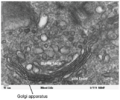Golgi complex facts for kids
The Golgi complex, also known as the Golgi apparatus or simply the Golgi, is a tiny part inside eukaryote cells. You can find it in animals, plants, and fungi. It's like a special factory in the cell that helps process and package important materials.
Contents
Discovering the Golgi Complex
The Golgi complex was found by a scientist named Camillo Golgi in 1898. At first, some people didn't believe him. They thought he was just seeing dirt on his microscope lenses! But years later, new electron microscopes showed structures exactly like what Golgi had drawn. This proved his amazing discovery.
What the Golgi Complex Looks Like
The Golgi complex is made of several flat, sac-like membranes. These membranes are stacked on top of each other. They look a bit like a stack of pancakes. This special shape helps the Golgi do its important work inside the cell.
How the Golgi Complex Works
The main job of the Golgi apparatus is to process and package large molecules. These molecules include proteins and lipids. They arrive at the Golgi after being made. The Golgi then checks them for any mistakes. It also removes any extra parts that aren't needed.
After checking, the Golgi wraps up these molecules. It then sends them to their correct places in or outside the cell. The Golgi complex is very busy when it processes proteins that the cell needs to release. It even releases special enzymes called lysosomes. These enzymes help clean off extra amino acids. Once a package is ready, it pinches off from the Golgi. Then it is released into the cell's cytoplasm.
The Golgi complex is part of the cell's membrane system. The endoplasmic reticulum is also part of this system. The Golgi has two sides, or "faces." These are called the maturation face and the formation face.
Images for kids
-
Micrograph of Golgi apparatus, visible as a stack of semicircular black rings near the bottom. Numerous circular vesicles can be seen in proximity to the organelle.
See also
 In Spanish: Aparato de Golgi para niños
In Spanish: Aparato de Golgi para niños




